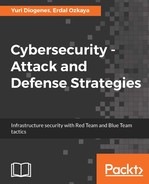Following a successful attack, attackers will try to map out the hosts in a network in order to discover the ones that contain valuable information. There are a number of tools that can be used here to identify the hosts connected in a network. One of the most commonly used is nmap and this section shall explain the mapping capabilities that this tool has. The tool, like many others, will list all the hosts that it detects on the network through a host discovery process. This is initiated using a command to scan an entire network subnet as shown in the following:
#nmap 10.168.3.1/24
A scan can also be done for a certain range of IP addresses as follows:
#nmap 10.250.3.1-200
The following is a command that can be used to scan specific ports on a target:
#nmap -p80,23,21 192.190.3.25
With this information, the attacker can go ahead and test the operating system running on computers of interest in a network. If the hacker can tell the operating system and particular version running on a target device, it will be easy to select hacking tools that can effectively be used.
The following is a command used to find out the operating system and version running on a target device:
#nmap -O 191.160.254.35
The nmap tool has complex OS fingerprinting capabilities and will almost always succeed in telling us the operating systems of devices, such as routers, workstations, and servers.
The reason why network mapping is possible, and to a large extent easy to do, is because of the challenges involved in protecting against it. There is an option for organizations to completely shield their systems to prevent the likes of nmap scans, but this is mostly done through network intrusion detection systems (NDISs). When hackers are scanning individual targets, they scan a local segment of a network and thus avoid passing through NDISs. To prevent the scan from happening, an organization can opt to have host-based intrusion detection systems, but most network administrators will not consider doing that in a network, especially if the number of hosts is huge.
The increased monitoring systems in each host will lead to more alerts and require more storage capacity and depending, on the size of the organization, this could lead to terabytes of data most of which would be false positives. This adds on to the challenge that security teams in organizations have whereby they only have sufficient resources and willpower to investigate, on average, 4% of all cybersecurity alerts generated by security systems. The constant detection of false positives in voluminous quantities also discourages security teams from following up on threats identified in networks.
Factoring in the challenges of monitoring for lateral movement activities, the best hopes for victim organizations are host-based security solutions. However, hackers commonly come armed with the means to disable or blind them.
